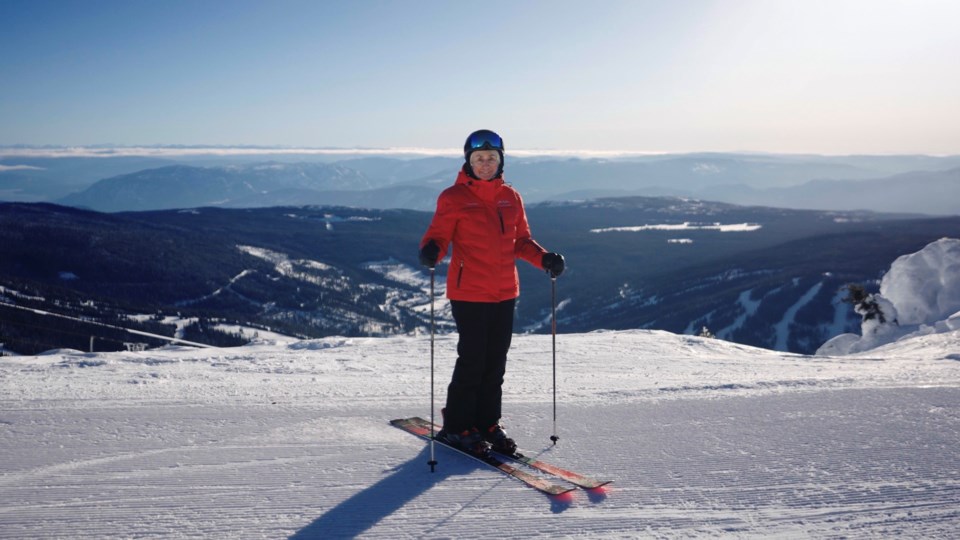In former Whistler Blackcomb president Hugh Smythe’s opinion, no one has done more for skiing in Canada than Nancy Greene Raine. The two-time Olympic medallist has made it to the ripe old age of 80, yet remains capable of getting down a mountain with the speed and dexterity of a woman decades younger. She’s sharp, vibrant, and the fire in her heart still burns.
Andrea Wing is among the latest to pay tribute to N.G.R. in her new project: The Fabulous Life of Nancy Greene Raine. Combining iconic photographs and rarely-seen archival footage with snappy narration and crisp on-mountain footage shot at Sun Peaks, the mini-documentary allows guests at the Vancouver International Mountain Film Festival (VIMFF) to appreciate what made Greene Raine tick in a fun and fast-paced format.
The Canada Sports Hall of Famer has achieved much more in life than can be encapsulated within a 10-minute runtime. She’s got a pair of overall world titles and 13 World Cup victories in addition to her Olympic glory. The ski league bearing her name has nurtured many talents, from Ashleigh McIvor to Steve “The Young One” Podborski. Greene Raine even spent nearly a decade as a senator, using her political platform to advocate for health and fitness.
“We really wanted to focus on her—not only career, but what she was like and the way that she gave back to her community, particularly the racing program,” explained Wing. “There are so many other details that we left out, but what we did was focus on those big tentpole moments … especially leaning into the moments where we had great supporting footage.
“I grew up ski racing in Ottawa. Nancy’s name and programs were definitely a part of my childhood, and I think her legacy continues at a lot of these ski hills. I feel like what she has done is bring a very fun program to young skiers and really help them fall in love with the sport.”
Other names dominate the women’s skiing airwaves of today: names like Mikaela Shriffrin, Petra Vlhova, Sandra Naeslund and—among Canadians—Valérie Grenier and Marielle Thompson. Yet Greene Raine’s impact continues to live on, including and especially in Whistler.
Birth of a ski resort
The entire Sea to Sky corridor owes Greene Raine and her husband Al a debt of gratitude.
In 1970, the couple built their first cabin in Whistler, which became their summer home. Five years later, Al retired from coaching and they moved up north full-time, intending to mould the picturesque dot on the map into something special.
“We loved our time in Whistler,” said Greene Raine. “Back then, there were probably less than 40 telephones in the whole valley—a very small full-time population. We were involved in the Chamber of Commerce and all those things. It was really fun to be a part of Whistler growing.”
Wing’s film notes Whistler was just “a twinkle in the eye of ski bums across the country” 50-plus years ago. Greene Raine and Al set out to establish a European-style pedestrian-friendly village connecting Blackcomb with Whistler Mountain, and they each brought a key piece to the table.
Greene Raine leveraged her celebrity status as one of skiing’s best-known champions to become an ambassador and spokeswoman for the then-fledgling resort. Her name alone was often enough to convince bankers and power brokers to sit down for a meeting. Al, meanwhile, played a central role in the planning, design and construction of Blackcomb Mountain and Whistler Village.
A remarkable transformation occurred, as a former garbage dump blossomed into a world-class snowsport destination.
Eventually the couple departed to work their magic in Sun Peaks, but they retain fond memories of their era in the Sea to Sky.
Chase or be chased
It may be curious to some that Greene Raine retired at the peak of her skiing powers: 24 years of age. No doubt she’s given her whole life to the advancement of sport and recreation in Canada, but you can’t help but wonder: did she have more in the tank as a competitor?
She sure did, but there were other considerations on her mind—namely the amateur paradigm that prevented athletes from earning money off their sports. During her nine-year national team career, Greene Raine lived at home and worked as a secretary each summer to help fund her athletic pursuits. There was no prize money and no sponsorships to be had.
“If I won the races now that I won back then, I would have been making millions of bucks,” Greene Raine said. “Your career is much more extended now, but in those days, the driving force was your own desire to get to the top and be at the top.
“Especially after the 1968 Olympics, I went on a string for a month and a half where I won every race—downhill, slalom, giant slalom—by big margins … but [I remember] standing at the bottom of the slalom hill in Sun Valley, looking at a young American coming from the back of the pack with a hot time and thinking: ‘jeez, I’m the target.’ Like I said in the film, it’s more fun chasing than being chased.”
In the end, Greene Raine seized every opportunity that crossed her path and hopes today’s athletes will continue to do the same.
“Honestly, I always think: ‘oh my God, what if your sport was the shot put? What would you do afterwards?’” she remarked. “But in skiing, whether you’re in alpine or freestyle skiing, you make all kinds of contacts all over the place if you become well-known. There are a lot of job opportunities in many, many fields, whether it’s hospitality, small business, or instructing and working in the ski industry itself.”
The 2024 VIMFF runs from Feb. 23 to March 3. Learn more about The Fabulous Life of Nancy Greene Raine at vimff.org/film/the-fabulous-life-of-nancy-greene-raine/.




